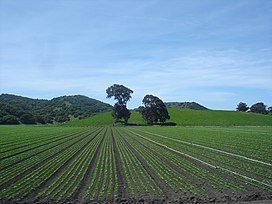
Monterey County, officially the County of Monterey, is a county located on the Pacific coast in the U.S. state of California. As of the 2020 census, its population was 439,035. The county's largest city and county seat is Salinas.

Castroville is an unincorporated town and census-designated place (CDP) in Monterey County, California, United States. At the time of the 2020 census the population was 7,515, up from 6,481 in 2010. Castroville is known for its artichoke crop and for the annual Castroville Artichoke Festival, leading to its nickname as the "Artichoke Center of the World".
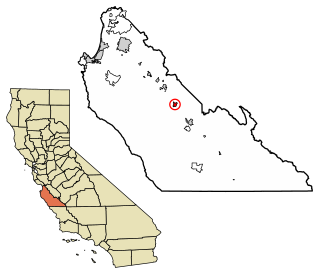
Greenfield is a city in Monterey County, California, United States. Formerly Clarke Colony, it lies in the Salinas Valley, 33 miles (53 km) southeast of Salinas, at an elevation of 289 feet (88 m). As of the 2020 census, the population was 18,937, up from 16,330 in the 2010 census. Its most well-known public event is the annual Harvest Festival. Greenfield is a member of the Association of Monterey Bay Area Governments.
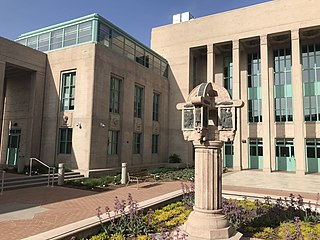
Salinas is a city in the U.S. state of California and the county seat of Monterey County. With a population of 163,542 in the 2020 Census, Salinas is the most populous city in Monterey County. Salinas is an urban area located along the eastern limits of the Monterey Bay Area, lying just south of the San Francisco Bay Area and 10 miles (16 km) southeast of the mouth of the Salinas River. The city is located at the mouth of the Salinas Valley, about eight miles (13 km) from the Pacific Ocean, and it has a climate more influenced by the ocean than the interior.

Soledad is a city in Monterey County, California, United States. It is in the Salinas Valley, 21 miles (34 km) southeast of Salinas, the county seat. Soledad's population was 24,925 at the 2020 census, down from 25,738 in 2010. Soledad's origins started with Mission Nuestra Señora de la Soledad, founded by the Spanish in 1791, under the leadership of Fermín de Lasuén. Catalina Munrás began developing the town of Soledad on her Rancho San Vicente in the 1860s, which eventually incorporated as a city in 1921. Today, Soledad is a notable tourist destination, owing to the heavily restored mission, its proximity to Pinnacles National Park, and its numerous vineyards, as part of the Monterey wine region.

The Salinas River is the longest river of the Central Coast region of California, running 175 miles (282 km) and draining 4,160 square miles (10,800 km2). It flows north-northwest and drains the Salinas Valley that slices through the central California Coast Ranges south of Monterey Bay. The river begins in southern San Luis Obispo County, originating in the Los Machos Hills of the Los Padres National Forest. From there, the river flows north into Monterey County, eventually making its way to connect with the Monterey Bay, part of the Pacific Ocean, approximately 5 miles (8.0 km) south of Moss Landing. The river is a wildlife corridor, and provides the principal source of water from its reservoirs and tributaries for the farms and vineyards of the valley.

The Salinan are a Native American tribe whose ancestral territory is in the southern Salinas Valley and the Santa Lucia Range in the Central Coast of California. Today, the Salinan governments are now working toward federal tribal recognition from the Bureau of Indian Affairs.

Carmel Valley is an American Viticultural Area (AVA) located in Monterey County, California, southeast of Carmel-by-the-Sea and it is one of the ten AVAs in the county. Approximately 100 miles (161 km) south of San Francisco, the AVA was recognized by the Bureau of Alcohol, Tobacco and Firearms (ATF), Treasury on January 13, 1983 after reviewing the petition submitted by Mr. David Armanasco, General Manager of Dumey Vineyard, located in Carmel, to propose a viticultural area named “Carmel Valley.”

Area code 831 is a telephone area code in the North American Numbering Plan for a small region of the U.S. state of California. The numbering plan area (NPA) comprises Monterey County, San Benito County, and Santa Cruz County. The area code was created in 1998 in an area code split of area code 408.
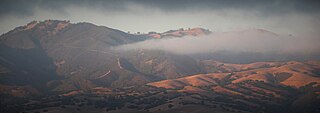
The Gabilan Range or Gabilán Range are a mountain range in the inner California Coast Ranges System, located in Monterey County and San Benito County of central California. Pinnacles National Park is located in the southern section of the range.
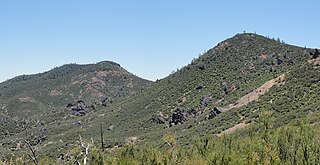
Chalone identifies the first American Viticultural Area (AVA) established in Monterey County, California straddling its border with San Benito County where it is the second established AVA. Chalone viticultural area is located in the Gabilan Mountains east of Soledad. It was recognized by the Bureau of Alcohol, Tobacco and Firearms (ATF) effective on July 14, 1982 after reviewing the petition submitted by the Gavilan Vineyards, Inc. to establish a viticultural area in Monterey and San Benito counties to be named "The Pinnacles." The area encompasses 8,640 acres (14 sq mi) and the proposed name was recognition of the nearby Chalone peaks.

The Nacimiento River is a 64.8-mile-long (104.3 km) river in southern Monterey County and northern San Luis Obispo County, California. A large portion of the river's run is on military reservations. The river's upper reaches are inside Fort Hunter Liggett, Lake Nacimiento is in the middle and the lower reaches are inside Camp Roberts. It is the largest tributary of the Salinas River in terms of streamflow.
The San Antonio Valley AVA is an American Viticultural Area centered on San Antonio Valley, California in southern Monterey County, California. The AVA was approved in July 2006 by the United States Department of the Treasury Alcohol and Tobacco Tax and Trade Bureau.
The San Lucas AVA is an American Viticultural Area located in Monterey County, California. It is located at the southern end of Salinas Valley, shares an eastern border with the Chalone AVA, and is bordered on the west by the Santa Lucia Range foothills. The appellation has the largest diurnal temperature variation of any of California's AVAs.
The Hames Valley AVA is an American Viticultural Area located in Monterey County, California at about 35°52'N 120°52'W, about 2 km west of US Route 101. It became an AVA in 1994. It is part of the larger Monterey AVA, and is located at the southern end of the Salinas Valley in the foothills of the Santa Lucia Range. The soil in the valley is shale and loam, and the climate is slightly warmer than other regions of Monterey. In addition to Bordeaux varietals, traditional Port grapes such as Tinta Cao and Touriga Nacional are grown in the valley. One recent significant wine is the 2008 Nybakken "IV Amici" Petite Syrah.
The Santa Lucia Highlands AVA is an American Viticultural Area located in Monterey County, California. It is part of the larger Monterey AVA, and located in the Santa Lucia Mountains above the Salinas Valley. Over 2,300 acres (931 ha) of vineyards are planted in the AVA, some as high as 1,200 feet (366 m) above sea level, with about half of them planted to the Pinot noir grape. The region enjoys cool morning fog and breezes from Monterey Bay followed by warm afternoons thanks to direct southern exposures to the sun.

Pisoni Estate is a family-owned and operated vineyard and winery located in the Santa Lucia Highlands of California’s Monterey Coast. It was founded in 1982 by Gary Pisoni, who was more interested in growing wine grapes than row crops for the family vegetable farm. He decided to plant a vineyard in the mountains above the Salinas Valley--an area previously considered undesirable for growing because of its dry, granitic soil. The vineyard began with small crops of Chardonnay, Cabernet Sauvignon, and Pinot Noir, then eventually focused on the Pinot Noir for which it has become renowned.
The River Road Wine Trail is a Salinas Valley wine-tasting route following River Road along the western banks of the Salinas River. It is not to be misidentified with the Great River Road that traverses along the banks of the Mississippi River through multiple states. The road also designates the eastern boundary of the Santa Lucia Highlands AVA and accesses many of the resident wineries contributing to local enotourism business. Due to its popularity, it is notably referenced in numerous books and magazines.

Monterey County wine is a appellation that designates wine made from grapes grown in Monterey County, California which lies entirely within the expansive multi-county Central Coast viticultural area. County names in the United States automatically qualify as legal appellations of origin for wine produced from grapes grown in that county and do not require registration with the Alcohol and Tobacco Tax and Trade Bureau (TTB). TTB was created in January 2003, when the Bureau of Alcohol, Tobacco and Firearms, or ATF, was extensively reorganized under the provisions of the Homeland Security Act of 2002.

Gabilan Mountains is an American Viticultural Area (AVA) located in the mountainous region on the border in Monterey and San Benito Counties in California. It is the tenth and newest AVA established in Monterey County by the Alcohol and Tobacco Tax and Trade Bureau (TTB) on September 14, 2022, becoming the state's 147th official AVA after the TTB reviewed the petition from Parker Allen of Coastview Vineyards, proposing to establish the "Gabilan Mountains" viticultural area. Gabilan Mountains encompasses about 98,000 acres (153 sq mi) including the established Mt. Harlan and Chalone AVAs, and resident to 4 wineries and 6 commercial vineyards cultivating approximately 436 acres (176 ha). The average elevation within the region is 2,370 feet (722 m) placing it above the heavy fog and marine layer. As a result, Gabilan Mountains AVA has a cool air climate without the humidity from the fog and low-lying clouds.
